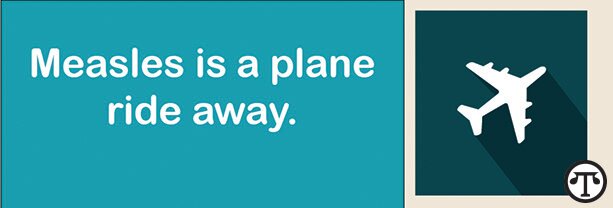FOR YOUR HEALTH: When Planning International Travel, Measles Vaccination is Peace of Mind for the Whole Family
 Before you travel with kids, it’s a good idea to make sure they’ve been vaccinated against measles.
Before you travel with kids, it’s a good idea to make sure they’ve been vaccinated against measles.
by Dr. David Sugerman
(NAPSI)—As a parent, I know that preparing for international travel with kids is more than just packing a suitcase. Whether we are visiting relatives we haven’t seen for a long time or helping our children see the world, we all can agree that protecting our family’s health is the top priority. As a doctor, I know that beyond sorting out missing socks and packing suitcases, there is another important step to prepare for international travel: measles vaccination. Your whole family needs to be protected by measles vaccination, including babies as young as six months old.
While the risk for measles in the U.S. remains thankfully low due to high rates of immunization, measles can occur anywhere in the world, and you can be exposed during international travel. Every year, U.S. residents who are unvaccinated get measles while traveling internationally and get sick after they come home, often spreading it to others. Measles is more than just a little rash; it’s a serious disease that can cause severe complications, especially in young children. Measles is also highly contagious. If one person has it, up to nine out of 10 people nearby can become infected if they are not vaccinated.
The good news is that two doses of the measles, mumps, and rubella (MMR) vaccine provide safe, long-lasting protection against measles. While most children receive their first dose of MMR vaccine around one year old, babies as young as six months old who are traveling overseas should get an early dose to help protect them when they are the most vulnerable. And while most children get their second dose after the age of four, children between one and four years of age should get a second dose before traveling internationally to provide the best protection.
Why risk being exposed away from home when you can protect the whole family by vaccination? It takes about two weeks to develop protection from the vaccine, so now is the time to plan before you take a trip. If your trip is less than two weeks away, you can still get a dose of MMR vaccine. As a reminder, college kids or young adults traveling might need a dose, too, if they didn’t get all of them as a children. As a doctor, I hope you will talk with your own doctor, nurse, or clinic about measles vaccination to protect the whole family. As a dad, I might never find that missing sock – but I’ll have peace of mind knowing my family is protected from disease by vaccination.
You can learn more about measles vaccination and how to plan for travel here at: https://www.cdc.gov/measles/travel/index.html.
Dr. David Sugerman is a medical officer in the Division of Viral Diseases, Centers for Disease Control and Prevention (CDC).




 While the Healthy Eating Pyramid is a good indicator of the types (and quantities) of foods we should eat to stay healthy, there are certain foods that are healthier than others when it comes to our eyes.
While the Healthy Eating Pyramid is a good indicator of the types (and quantities) of foods we should eat to stay healthy, there are certain foods that are healthier than others when it comes to our eyes. (NAPSI)—Incidents involving dog attacks on Postal Service employees rose to more than 5,800 cases last year—but you can help get those numbers down and keep your own mail delivery up.
(NAPSI)—Incidents involving dog attacks on Postal Service employees rose to more than 5,800 cases last year—but you can help get those numbers down and keep your own mail delivery up.
 (NAPSI)—If you’re like most Americans, you take a dietary supplement every day, according to a report from the National Institutes of Health (NIH).
(NAPSI)—If you’re like most Americans, you take a dietary supplement every day, according to a report from the National Institutes of Health (NIH).
 Lately is seems as though you can’t pass a park or court without spotting people engaged in a lively game of pickleball. The fast-moving sport seems to have come out of nowhere and captured the interest of young and old alike, who can’t get enough of it. With all that play there is inevitably the possibly of strain and injuries, caution chiropractors.
Lately is seems as though you can’t pass a park or court without spotting people engaged in a lively game of pickleball. The fast-moving sport seems to have come out of nowhere and captured the interest of young and old alike, who can’t get enough of it. With all that play there is inevitably the possibly of strain and injuries, caution chiropractors. These tips may help you stay on track with your plan to eat healthier.
These tips may help you stay on track with your plan to eat healthier.